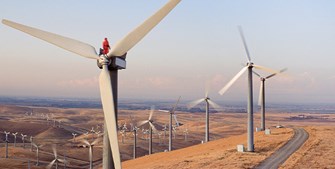Commercial real estate (CRE) and industrial facilities have immense energy needs and account for roughly 40 percent of energy use in the U.S. In 2022, landmark federal legislation was passed to encourage cleaner alternatives in the energy sector. The CHIPS and Science Act was passed to support the semiconductor plant (or Fabs) industry in reducing its carbon footprint. It also provides a 25 percent tax credit for new or expanded facilities. The Inflation Reduction Act (IRA) was passed in order to improve supply chains, invest in domestic energy manufacturing, provide consumer rebates for clean energy options and reduce carbon emissions by roughly 40 percent by 2030.
Developing more efficient, sustainable structures can help ensure a steady supply of affordable power and significantly lower operating costs for businesses. Here are the top alternative energy trends in CRE, as well as reasons why alternative energy is a smart choice for commercial property owners.
TOP ALTERNATIVE ENERGY TRENDS IN CRE
RENEWABLE ENERGY
In 2022, the renewable energy industry remained remarkably resilient. Decreasing costs, advances in technology and increased battery storage have made renewables one of the most competitive energy sources in the market. The most common forms of renewable energies are solar, wind and geothermal.
Solar: Solar photovoltaic (PV) systems are the most commonly reported and cost-competitive form of on-site renewable energy in CRE globally. Photovoltaic (PV) panels installed onto rooftops, garages and sun-exposed ground surfaces, or building-integrated photovoltaics (BIPVs) that are built into the façade of a structure itself, have a 25 to 30 year lifespan and have considerably decreased in cost over the past decade.
Ongoing research and innovation are constantly advancing solar technology, allowing CRE developers to incorporate diverse solar options, such as floating solar farms (or “floatovoltaics”) that are built on reservoirs, dams and other water bodies. Floating solar farms can generate electricity without taking up valuable land or real estate. Another innovation includes solar skins, which allow CRE developers to customize solar panels to fit the aesthetic needs of their clients.
Wind: Wind power, harnessed by generating electricity via wind turbines, is much more common at the utility scale rather than the commercial scale. However, the number of corporations, businesses, and others investing in or using wind power to fuel their energy needs is growing.
A corporation can power all or part of its headquarters or other company operations by purchasing a wind project’s electricity output and, at the same time, demonstrate its responsiveness to environmental concerns by purchasing electricity from a renewable source.
Geothermal: For commercial buildings in certain parts of the United States, harnessing geothermal energy is another option. This type of energy is created when ground-source heat pumps use ambient ground temperature to heat or cool water. Depending on the design of the system, on-site geothermal systems can supply up to 100 percent of a building’s heating and cooling loads.
A geothermal-adjacent option is a green roof, a vegetative layer grown on a rooftop that provides shade, removes heat from the air and reduces temperatures of the roof surface. Using green roofs in cities with limited vegetation can moderate the daytime heat island effect often found in concentrated urban areas.
GREEN HYDROGEN ENERGY
Hydrogen is an abundant material and produces close to zero greenhouse gas emissions when combusted, two qualities that make it a very exciting potential source of energy. The challenge has always been that converting it into a safe form of fuel that does not pollute the environment. Enter green hydrogen, created using electrolysis and water, and generating electricity from renewable sources like wind or solar power — effectively making the production process carbon-free.
AI & THE INTERNET OF ENERGY
Energy industry analysts forecast that Artificial Intelligence (AI) will play a major role in the world’s transition to clean energy. The development of predictive maintenance technology, forecasting of supply and demand, and a shift to decentralized models of power generation and distribution in which power is generated by smaller, localized power grids like solar farms will require the coordination and integration of these networks through complex AI algorithms.
The Internet of Energy (IoE) is a smart energy infrastructure system that incorporates the principles of the Internet of Things (IoT) to connect every point within the power grid: generation, load, distribution, storage and smart meters. It uses sensors and scanners to process information both close to the energy source, as well as via remote data centers, in order to carry out specific functions. This technology is currently being used for things such as biometric monitoring, logistical tracking and controlling systems in smart buildings. Future applications could make it possible for utility companies to conduct real-time, data-driven diagnoses and predictive maintenance, intended to improve efficiency and customer service.
WHY ALTERNATIVE ENERGY SOURCES?
Alternative energy sources reflect a responsiveness to environmental concerns and smart business strategy and community strategies, including:
- Tax credit incentives for businesses, like the CHIPS Act and Inflation Reduction Act.
- Return on investment (ROI): In 2021, respondents of a green building trends survey projected that new green buildings and/or green renos or retrofits would reduce operating costs by 12.3 to 13.5 percent within one year and 17.9 percent over the next five years.
- Alignment with local regulations and green building certifications.
- Customer and shareholder satisfaction; customers want to support eco-friendly businesses.
- Renewable energy sources that provide power, in whole or in part, to local communities.
- Benefits to the local community, including tax advantages for school districts.
Ongoing research and innovations in alternative energy are constantly creating new possibilities in CRE, and Old Republic Title is a significant industry player when it comes to insuring title for renewable energy projects. From utility scale wind and solar farms, natural gas power plants, battery storage facilities, and other energy project portfolios, we have the experience and expertise to support complex transaction structures for alternative and sustainable energy projects. For more information, visit oldrepublictitle.com/commercial/ncs.




